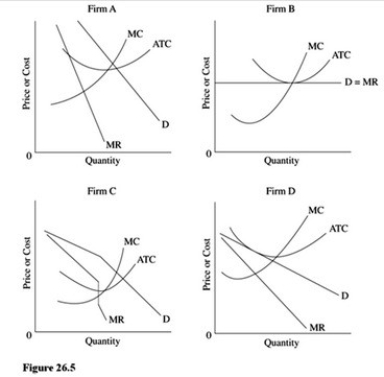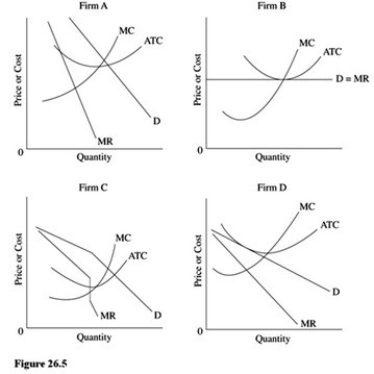A) Perfect competition,oligopoly,and monopolistic competition.
B) Perfect competition,but not oligopoly or monopolistic competition.
C) Perfect competition and oligopoly,but not monopolistic competition.
D) Oligopoly and monopolistic competition,but not perfect competition.
Correct Answer

verified
Correct Answer
verified
Multiple Choice
Entry into a market characterized by monopolistic competition is generally
A) Entirely blocked by existing firms.
B) Very easy because few barriers exist.
C) As difficult as in oligopoly.
D) More difficult than entry into monopolized markets.
Correct Answer

verified
Correct Answer
verified
Multiple Choice
Which of the following characterizes monopolistic competition?
A) Price leadership.
B) Zero long-run profit.
C) Retaliation.
D) Marginal cost pricing.
Correct Answer

verified
Correct Answer
verified
Multiple Choice
 Refer to Figure 26.5.Which firm is least likely to engage in advertising?
Refer to Figure 26.5.Which firm is least likely to engage in advertising?
A) Firm A only.
B) Firm B only.
C) Firm C only.
D) Firms A,C,and D.
Correct Answer

verified
Correct Answer
verified
True/False
The monopoly aspect of monopolistic competition is that there is only one seller.
Correct Answer

verified
Correct Answer
verified
Multiple Choice
When new firms enter a monopolistically competitive industry,the market
A) Supply curve shifts to the left.
B) Supply curve shifts to the right.
C) Demand curve shifts to the left.
D) Demand curve shifts to the right.
Correct Answer

verified
Correct Answer
verified
Multiple Choice
The demand curve faced by a monopolistically competitive firm is
A) Downward-sloping.
B) Flat.
C) Kinked.
D) Upward-sloping.
Correct Answer

verified
Correct Answer
verified
Multiple Choice
Which of the following is not true about a monopolistic competitor?
A) It maximizes profit at the point where MC = MR.
B) It produces less output than a perfectly competitive firm,ceteris paribus.
C) It charges a higher price than a perfectly competitive firm,ceteris paribus.
D) It can earn economic profits in the long run.
Correct Answer

verified
D
Correct Answer
verified
Essay
If monopolistically competitive firms have some control over the prices they charge,why do they experience zero economic profits in the long run?
Correct Answer

verified
The key is the relatively easy entry into monopolistically competitive markets.If a typical firm is experiencing economic profits in the short run,new firms will enter the market,reducing the demand and increasing the price elasticity for the typical firm's product.This process will continue as long as there are economic profits-that is,competition will force economic profits to zero in the long run.
Correct Answer
verified
True/False
Monopolistically competitive firms use marginal cost pricing.
Correct Answer

verified
Correct Answer
verified
Multiple Choice
If economic profits are earned in a monopolistically competitive market,
A) More firms will enter the market.
B) The market supply curve will shift to the left.
C) Price will rise.
D) The market demand curve will shift to the right.
Correct Answer

verified
Correct Answer
verified
Multiple Choice
A monopolistically competitive firm can raise its price somewhat without fear of great change in unit sales because
A) The demand for its product is typically very price-elastic.
B) Its demand curve is horizontal.
C) Of product differentiation and brand loyalty.
D) Of the gap in its marginal revenue curve.
Correct Answer

verified
Correct Answer
verified
Multiple Choice
 Which of the firms in Figure 26.5 is most likely a monopoly in the long run?
Which of the firms in Figure 26.5 is most likely a monopoly in the long run?
A) Firm A.
B) Firm B.
C) Firm C.
D) Firm D.
Correct Answer

verified
Correct Answer
verified
True/False
Advertising plays a role in reducing the cross-price elasticity of demand.
Correct Answer

verified
Correct Answer
verified
True/False
In monopolistic competition,each firm competes with other firms offering identical substitutes.
Correct Answer

verified
Correct Answer
verified
True/False
For a monopolistically competitive firm,barriers to entry are high,which allows the firm to earn positive economic profits in the long run.
Correct Answer

verified
Correct Answer
verified
True/False
Monopolistic competition results in allocative efficiency.
Correct Answer

verified
Correct Answer
verified
Multiple Choice
Which of the following is similar for oligopoly and monopolistic competition?
A) Both have many firms.
B) Both have low concentration ratios.
C) Both have market power.
D) Both make independent production decisions.
Correct Answer

verified
Correct Answer
verified
True/False
A monopolistically competitive firm that runs a successful advertising campaign creates enormous goodwill,but this goodwill does little to increase the value of the company.
Correct Answer

verified
Correct Answer
verified
Multiple Choice
Which of the following is not an example of nonprice competition in the airline market?
A) A low concentration ratio.
B) Advertising on the radio.
C) More on-time flights.
D) Increased frequency of flights.
Correct Answer

verified
A
Correct Answer
verified
Showing 1 - 20 of 144
Related Exams